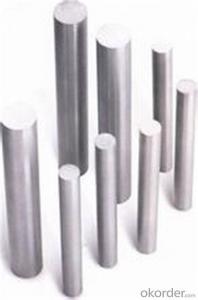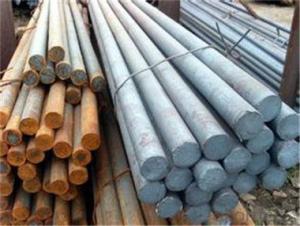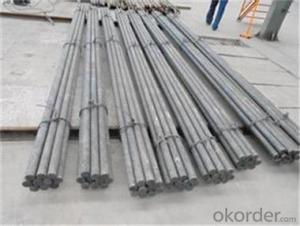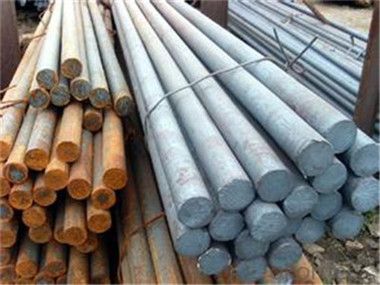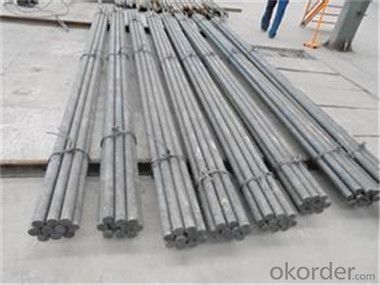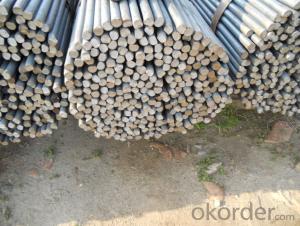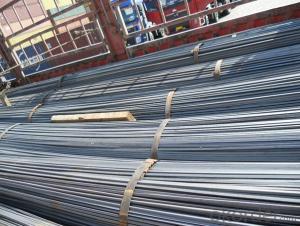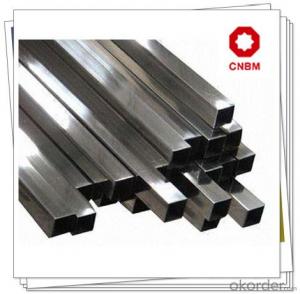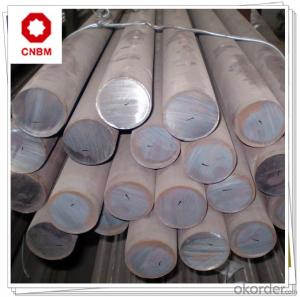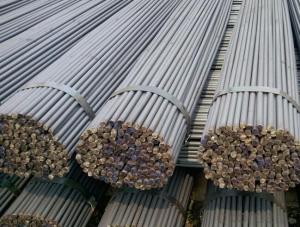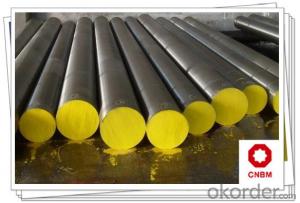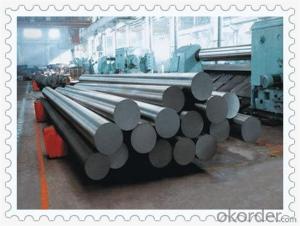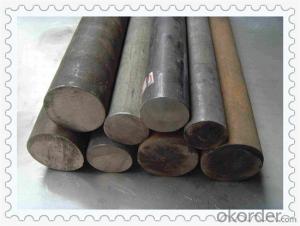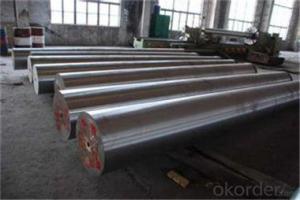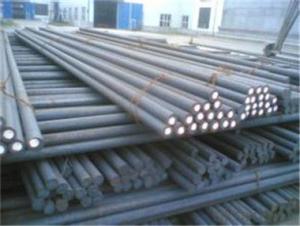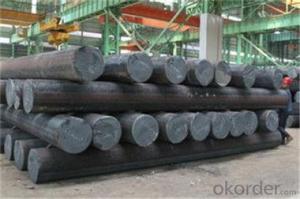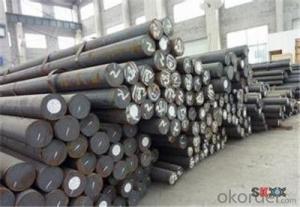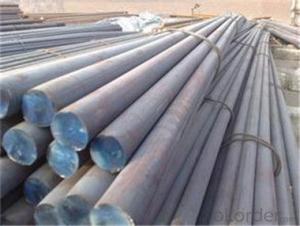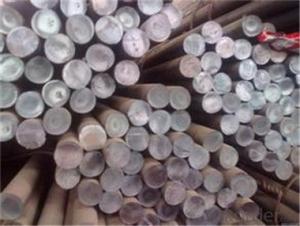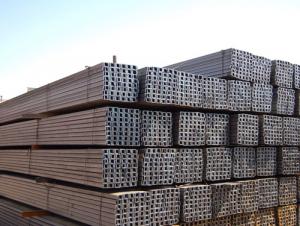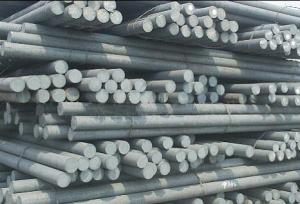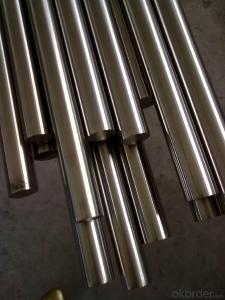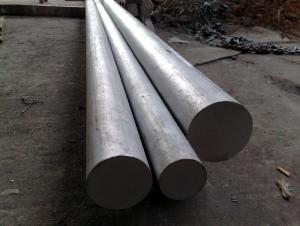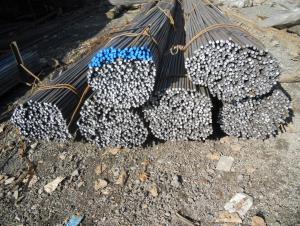Steel Round Bars Reliable Manufacturer from China
- Loading Port:
- Tianjin
- Payment Terms:
- TT OR LC
- Min Order Qty:
- 400 m.t.
- Supply Capability:
- 4555553 m.t./month
OKorder Service Pledge
OKorder Financial Service
You Might Also Like
Description of steel round bar:
1. Commodity: Round steel bar
3. Technical: Hot rolling
2. Length: Min. 5.8meter, according to requirement.
Festures of steel round bar:
1.Dia 80-800mm Length:2000-13000mm or as required
2.Technique:Forged
Specifications of steel round bar:
1. Standards: AISI 4340 8620 8640 4320 , JIS SNCM8 GB:40CrNiMoA
2. Specification: Dia: 80~450mm Length:2000-13000mm or as required
3. Process: EAF+LF+VD ( necessary) UT+ Peeled +Turned + Heat Treatment (optional). It is used in the manufacture of a higher strength and higher quenching and tempering section of the 35CrMo steel, like big locomotive traction gears, supercharger drive gear, rear axle, the connecting rod and the spring load greatly clip,it can also be used for 2000m following oil well drill pipe joints and fishing tools,and can be used for bending machine dies, etc.
4. Chemical Composition (%):
C | Si | Mn | S | P | Cr | Ni | Cu | Mo |
0.37-0.44 | 0.17-0.37 | 0.40-0.80 | 0.025(max) | 0.025(max) | 0.60-0.90 | 1.25-1.65 | 0.025(max) | 0.15-0.25 |
Images of steel round bar:
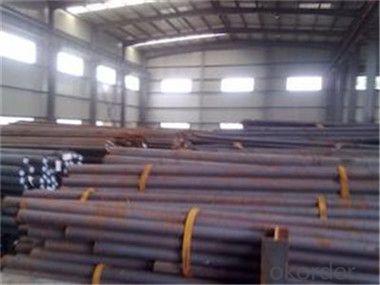
FAQ:
1. What is your package?
Packing situation: standard seaworthy packing or as customer required.
2. How long is the lead time?
Delivery time: 45 days after order confirmed.
- Q: What are the weight calculations for steel round bars?
- The weight calculations for steel round bars can be determined using a straightforward formula. The weight of a steel round bar can be calculated by multiplying the square of the diameter in millimeters by the length in meters and then multiplying the result by the specific weight of steel, which is typically around 7.85 grams per cubic centimeter. The formula for calculating the weight of a steel round bar is as follows: Weight = (Diameter^2 x Length x Specific Weight of Steel) / 1000 Where: - Diameter is the diameter of the round bar in millimeters - Length is the length of the round bar in meters - Specific Weight of Steel is the density of steel, which is usually 7.85 grams per cubic centimeter - 1000 is used to convert the weight from grams to kilograms It is important to note that this formula assumes the round bar is made of pure steel and does not account for any variations in the specific weight of different steel alloys. Additionally, it is crucial to use consistent units throughout the calculation, either millimeters or meters, to obtain accurate results.
- Q: On the market, 8mm Round Bar is not 9 meters a root? How much does it weigh about 300 meters? How much does it cost?
- The weight is 0.395 kilograms / meter by the theory. Can be rolled, is not the foot, the largest is 7.5 diameter, the price depends on the place, and the price is different from place to place
- Q: How are steel round bars measured and specified?
- Steel round bars are measured and specified based on their diameter. The diameter of a round bar is typically measured in millimeters (mm) or inches (in). The measurement is taken across the widest point of the circular cross-section. In terms of specification, steel round bars are commonly specified by their diameter and length. For example, a specification for a steel round bar may be written as "25mm diameter x 3 meters length". This means that the bar has a diameter of 25mm and a length of 3 meters. Additionally, steel round bars may also be specified based on their tolerance, surface finish, and grade. Tolerance refers to the allowable deviation from the specified diameter. Surface finish refers to the quality of the bar's surface, which can range from rough to smooth. Grade refers to the quality and composition of the steel used to make the round bar, such as mild steel, carbon steel, or alloy steel. It is important to accurately measure and specify steel round bars to ensure that they meet the required dimensions and properties for a particular application.
- Q: Can steel round bars be used for making brake components?
- Yes, steel round bars can be used for making brake components. Steel is a commonly used material in brake systems due to its high strength, durability, and heat resistance properties. Steel round bars can be machined and shaped into various brake components such as brake discs, brake rotors, brake calipers, and brake pistons. The use of steel round bars ensures the brake components can withstand the high pressures and temperatures generated during braking, providing reliable and efficient stopping power.
- Q: Can steel round bars be used in the automotive manufacturing?
- Yes, steel round bars can be used in automotive manufacturing. Steel round bars offer high strength and durability, making them suitable for various automotive components such as crankshafts, camshafts, axles, and suspension parts. They also provide excellent machinability and can be easily fabricated into the required shapes and sizes, making them a preferred choice in the automotive industry.
- Q: What are the advantages of using high-speed steel round bars?
- There are several advantages of using high-speed steel (HSS) round bars in various applications. Firstly, HSS round bars are known for their exceptional hardness and wear resistance. This makes them ideal for cutting, shaping, and machining operations that involve high-speed and high-temperature conditions. HSS round bars can withstand the heat generated during these processes without losing their hardness or dulling quickly, resulting in improved tool life and reduced downtime for tool changes. Secondly, HSS round bars have excellent strength and toughness properties. This enables them to handle heavy loads and resist deformation, even under demanding applications. The strength and toughness of HSS round bars make them suitable for use in industries such as aerospace, automotive, and manufacturing, where precision and reliability are critical. Thirdly, HSS round bars offer superior cutting performance. Due to their high hardness, HSS round bars can retain a sharp cutting edge for an extended period. This allows for efficient and precise cutting, reducing the chances of inaccuracies or errors in the workpiece. The sharp cutting edge also contributes to improved surface finish and dimensional accuracy. Additionally, HSS round bars have good thermal conductivity, meaning they can efficiently dissipate heat generated during cutting or machining operations. This prevents overheating, which can lead to premature tool failure or damage. The ability of HSS round bars to manage heat buildup helps maintain the integrity of the tool and extends its lifespan. Lastly, HSS round bars are readily available and cost-effective compared to other high-performance tool materials like carbide. This makes them a popular choice for a wide range of applications, especially in industries where cost considerations are significant. In conclusion, the advantages of using high-speed steel round bars include exceptional hardness and wear resistance, excellent strength and toughness, superior cutting performance, good thermal conductivity, and cost-effectiveness. These advantages make HSS round bars a preferred choice for professionals and industries that require reliable and efficient cutting and machining tools.
- Q: Are steel round bars suitable for machining applications?
- Yes, steel round bars are suitable for machining applications. Steel round bars are known for their excellent machinability, which means they can be easily shaped, cut, and drilled using various machining techniques such as turning, milling, drilling, and grinding. They are commonly used in industries such as automotive, aerospace, construction, and manufacturing, where precision and durability are crucial. Steel round bars offer high strength, toughness, and resistance to wear, making them ideal for machining applications that require high-performance components or parts. Additionally, steel round bars are available in a wide range of grades and sizes, allowing for versatility in meeting specific machining requirements.
- Q: What are the different surface treatments available for steel round bars?
- There are several different surface treatments available for steel round bars, each designed to enhance the material's properties and improve its overall performance. Some common surface treatments for steel round bars include: 1. Hot-dip galvanizing: This process involves immersing the steel round bars in a bath of molten zinc, forming a protective coating on the surface. Hot-dip galvanizing provides excellent corrosion resistance, making it suitable for outdoor applications or environments where the steel is exposed to moisture. 2. Electroplating: Electroplating is the process of depositing a thin layer of metal onto the surface of the steel round bars using an electric current. This treatment can provide enhanced corrosion resistance, improved appearance, or specific functional properties, depending on the metal used for electroplating. 3. Powder coating: Powder coating involves applying a dry powder paint to the surface of the steel round bars, which is then cured by heat to form a protective and decorative coating. This treatment offers excellent durability, resistance to corrosion, and a wide range of color options. 4. Black oxide coating: Black oxide coating is a chemical treatment that creates a dark, matte finish on the surface of the steel round bars. It provides moderate corrosion resistance and enhances the material's appearance, making it suitable for decorative or non-reflective applications. 5. Chrome plating: Chrome plating is a process of electroplating a thin layer of chromium onto the surface of the steel round bars. This treatment enhances corrosion resistance, improves wear resistance, and provides a shiny, reflective finish. 6. Nitriding: Nitriding is a heat treatment process that diffuses nitrogen into the surface of the steel round bars, forming a hardened layer. This treatment improves the material's hardness, wear resistance, and fatigue strength, making it suitable for applications requiring high strength and durability. 7. Anodizing: Anodizing is commonly used for aluminum, but it can also be applied to steel round bars. This electrolytic process creates a protective oxide layer on the surface, enhancing corrosion resistance and providing a decorative and durable finish. These are just a few examples of the different surface treatments available for steel round bars. The choice of treatment depends on the specific requirements of the application, such as corrosion resistance, wear resistance, appearance, or functional properties needed.
- Q: Can steel round bars be used in the electronics industry?
- Steel round bars can be used in the electronics industry, but their applications are generally limited. While steel is a strong and durable material, it is not typically utilized in electronic components or circuitry due to its electrical conductivity properties. In the electronics industry, materials with high electrical conductivity, such as copper or aluminum, are usually preferred. These materials allow for efficient transmission of electrical signals and minimize losses. However, steel round bars can find some applications in the electronics industry. They can be used for structural purposes, such as providing support or reinforcement to electronic equipment or enclosures. Steel bars can also be utilized in the manufacturing of various mechanical components, connectors, or fixtures used in electronics assembly. Additionally, steel round bars can be employed in the construction of equipment racks, shelves, or storage systems for electronic devices. Overall, while steel round bars may not be directly involved in the electrical aspects of the electronics industry, they can still serve important functions in terms of structural support and mechanical components.
- Q: What is the maximum length of a steel round bar that can be produced?
- Various factors, including the manufacturing process, equipment size and capacity, and logistical constraints, dictate the maximum length of a steel round bar. Typically, steel round bars can range from a few feet to several hundred feet in length. However, it is important to acknowledge that longer lengths may have certain limitations or considerations. For instance, hot rolling mills often determine the maximum length of a steel round bar based on the size and capacity of the rolling mill. The bar's length must fall within a range that the machinery can effectively roll and process. Additionally, transportation and handling logistics can also impose restrictions on the maximum length of a steel bar. Longer bars may necessitate specialized equipment or meticulous planning to ensure safe and efficient movement. Consequently, considering the specific production capabilities and constraints of the steel manufacturer or supplier becomes crucial when determining the maximum length of a steel round bar that can be produced.
Send your message to us
Steel Round Bars Reliable Manufacturer from China
- Loading Port:
- Tianjin
- Payment Terms:
- TT OR LC
- Min Order Qty:
- 400 m.t.
- Supply Capability:
- 4555553 m.t./month
OKorder Service Pledge
OKorder Financial Service
Similar products
Hot products
Hot Searches
